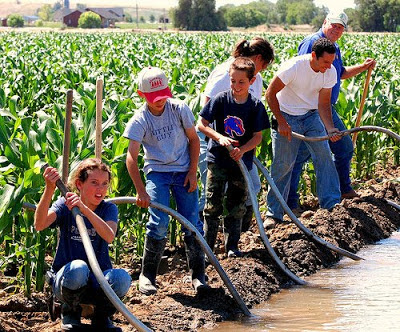When it
comes down to the behind the scenes of agriculture we can’t forget to tell the
story that agriculture is more. There is much more than just food on the
shelves and another controversy of what the new study says is healthier to feed
your child. When it comes down to it, agriculture truly comes down to people.
Agriculture as an entity exists as much of the same individuals as trusted by
your grandparents and great-grandparents of generations past. Producers and
farmers are your neighbors down the road, they are real people and real
families working hard towards raising healthy crops and livestock in order to feed
tomorrow’s world. At the end of the day there will always be real people with
their own lives, their own bills, their own hardships, and their own children
to put food on the table for working behind the scenes. These farmers and producers are worried about so much more than mass production, they are worried about their communities and neighbors at large. Farmers and producers are giving back to their communities
each day through the creation of jobs, volunteering, offering farm tours, etc. The U.S. population is fed three times a day,
every day by an estimated only 2% of the population (those in which are
directly involved in agriculture). It’s time for the 98% of the population to
stand up and appreciate the hard working individual’s blood, sweat, and tears
that go into every meal you consume rather than questioning their every move.
Have you thanked someone in agriculture lately?
Friday, August 12, 2016
Monday, August 8, 2016
Home in the House
 In the past several years there has been a dramatic shift in
the public’s perception of how their food should be produced. As an agriculture
entity we recognize that there is no “one size fits all” when it comes to food preferences,
which is why such a vast variety of niche market exist. A particularly
interesting trend and niche market to me that is growing quite rapidly in
popularity is that of the new cage free and anti-gestation crate movement along
with the notion of free roaming, as well as group housing animal production. The
consumer lacks the knowledge to understand why animal housing is the way it is
and often time uses emotion to come to their conclusions rather than reason. We
are going to use sows gestation crates as a specific example. For just a moment
reel your personal perceptions about gestation crates and your mental image of
the housing unit, and allow me to explain the purpose. Sows have a natural
aggression and tend to fight, the individual housing allows for the animals to
remain safe from one another and injury to themselves and/or other sows.
Another purpose and benefit that comes the use of the crates is that the sows
are able to be given individual care due to being seen daily up close and by
themselves, allowing for better healthcare. Protection from environmental
elements is another big benefit to the gestation crates due to their indoor
locations. A large population of the hogs in the United States is located in
the Midwest, and more specifically in Iowa. If anyone knows anything about the
Midwest it is that the weather is not predictable there and thus making indoor
housing much more sensible and feasible when it comes to producing hogs. The same
sort of stories and situations are similar in regards to other livestock housing
systems as well. Efficiencies as well as individual animal care can be improved
through various housing techniques.
In the past several years there has been a dramatic shift in
the public’s perception of how their food should be produced. As an agriculture
entity we recognize that there is no “one size fits all” when it comes to food preferences,
which is why such a vast variety of niche market exist. A particularly
interesting trend and niche market to me that is growing quite rapidly in
popularity is that of the new cage free and anti-gestation crate movement along
with the notion of free roaming, as well as group housing animal production. The
consumer lacks the knowledge to understand why animal housing is the way it is
and often time uses emotion to come to their conclusions rather than reason. We
are going to use sows gestation crates as a specific example. For just a moment
reel your personal perceptions about gestation crates and your mental image of
the housing unit, and allow me to explain the purpose. Sows have a natural
aggression and tend to fight, the individual housing allows for the animals to
remain safe from one another and injury to themselves and/or other sows.
Another purpose and benefit that comes the use of the crates is that the sows
are able to be given individual care due to being seen daily up close and by
themselves, allowing for better healthcare. Protection from environmental
elements is another big benefit to the gestation crates due to their indoor
locations. A large population of the hogs in the United States is located in
the Midwest, and more specifically in Iowa. If anyone knows anything about the
Midwest it is that the weather is not predictable there and thus making indoor
housing much more sensible and feasible when it comes to producing hogs. The same
sort of stories and situations are similar in regards to other livestock housing
systems as well. Efficiencies as well as individual animal care can be improved
through various housing techniques.
Subscribe to:
Comments (Atom)
